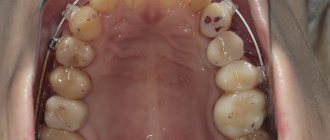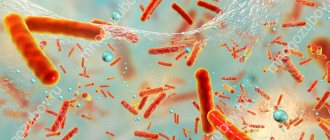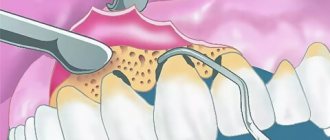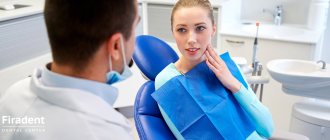Treatment of dental anomalies (deviations) should begin in childhood, because they can cause multiple problems: the formation of malocclusion, deformation of facial features, incorrect diction.
Interesting! Dentists often encounter very unusual and curious anomalies. For example, one Indian guy had 232 teeth removed. The thing is that the teenager was diagnosed with a tumor on the lower jaw, consisting of teeth. Another interesting case occurred in Saudi Arabia. A young man had a tooth that was growing in his nose removed.
What are the anomalies?
Dental anomalies can be congenital or acquired. Dental defects are a common pathology, especially in preschool children. Therefore, it is important not only to carry out treatment on time, but also to visit a doctor for early detection of disorders.
Types of deviations:
- teeth that are too big or small;
- abnormal number of teeth;
- irregular shape;
- defect in the structure of hard tissues;
- early or late periods of eruption;
- incorrect location;
- non-standard enamel color;
- malocclusion.
Why is it necessary to treat such defects?
Because dental pathologies lead to:
- deformations of the jaws and facial features;
- malocclusion;
- inability to bite and chew food normally;
- problems with the gastrointestinal tract;
- speech defects;
- low self-esteem.
Dental problems, if left untreated, will lead not only to an unattractive smile, but also to problems with the gastrointestinal tract (gastritis, ulcers). Psycho-emotional personality disorders are also likely: low self-esteem, stress and depression due to ridicule from peers. All this significantly affects not only the quality of life of the child, but also the future of the adult.
CONCEPT OF ORTHODONTIC METHODS OF TREATMENT OF DENTAL ANOMALIES. TOOLS
Gryanko
A.A.
Voronezh State Medical University
named after N.N. Burdenko, Voronezh
Annotation.
The article is devoted to the classification of orthodontic methods for treating dentofacial anomalies, their effectiveness and the main tools for correcting defects of the dentofacial system.
Keywords:
orthodontic treatment methods, hardware treatment, instruments for the treatment of developmental defects of teeth and jaws.
Relevance.
Orthodontic treatment methods - methods used to restore and correct various types of deviations in the development of teeth in humans - are a relevant and popular branch of dentistry among the population. This type of dental services is indicated for use in the treatment of both pronounced dental anomalies (deviations in the number, shape, structure, curvature of teeth, their location, timing of appearance, location of both jaws), and as a way to eliminate so-called cosmetic defects.
Target.
Consideration of the main modern orthodontic methods of treating dentoalveolar anomalies. These types of treatment combine several independent methods, namely: therapeutic exercises (myotherapy), the use of specific orthodontic appliances, and sometimes surgery is included in this list; it is also possible to combine several methods of restoring the normal position of teeth in the oral cavity and forming correct occlusion
Basic materials.
Hardware treatment almost always includes a dynamic stage and a stage of passive maintenance and consolidation of the acquired effect (retention).
The shift of one or more teeth to a normal state with the help of devices is ensured by: an adjustable force-directed movement that is applied to a given object; the presence of properly selected durable protection, good and stable fastening of the device in the oral cavity; there must be no interference to restore the normal position of the object being corrected; There should be free space in the row of teeth where the incorrectly grown tooth will fit.
If we consider hardware treatment as the main method of treating dental anomalies, then, first of all, the doctor, to correctly assess the condition of the teeth and jaws, conducts a series of studies, namely, a panoramic X-ray is taken, and in more complex cases, a computed tomography. Next, using modern software, a computer 3D model of the shape of teeth and jaws is built and hardware systems suitable for each specific case are selected.
Existing orthodontic appliances can be classified according to several criteria.
According to the intended use - prophylactic (preventive), therapeutic and retention (maintain a given normal position).
Preventive dental appliances are designed to prevent the development of dental anomalies and deformations. They are able to eliminate the causes that cause malocclusions and malocclusions to develop. Vestibular plate, equilibrator, turntable - this is not a complete list of this group. Therapeutic orthodontic devices can eliminate many defects of the oral cavity. Depending on the principle of operation, they are divided into:
-mechanical action, when abnormally located teeth are restored to the correct original position due to the active action of force applied by the doctor in the desired area using the constituent components of the structure (driving screw connections, brackets, springs, wires). This group includes the Angle device, various types of bracket systems, brackets with springs and screw fastenings, and expansion bars. When choosing this type of device, special attention is paid to the force of the applied pressure; it should not exceed the capillary pressure in the blood vessels, i.e. be about 20g/cm2. The device of Dr. Edward Engle is usually classified as a multifunctional type of dental appliance. It is shown in a spring form as a lateral dentition expander, in a fixed version it is used as a corrective mechanism for moving a tooth from an abnormal location to a normal one, and a sliding mechanism is suitable for preventing abrasion of the anterior teeth;
— functional guides, characterized by the presence of a surface located at an angle. The teeth or jaw being corrected move in a predetermined direction created by the oblique surface by concentrating pressure on individual teeth when the facial muscles contract while eating. This group includes the Brückle device, Katz dental strips, and onlays with a choice of inclination angle. For example, the Brückle device is made in the form of a plate with a sloped surface, which is attached in the area of the lower jaw in place of the front teeth, connected by an arch and has proven itself in restoring a prognathic bite, as well as in the active treatment phase for the correct mutual relationship of both dental rows of the anterior location.
- acting functionally - their installation enhances or, on the contrary, limits the growth rate of the jaw parts of the skull or their individual sections. The principle of operation is based on the use of dosed influence of different facial muscle groups, both on individual teeth and on the entire dentition. This type of device is designed to normalize processes such as normal breathing, speech, chewing, and also restore the symmetry of the maxillofacial area. This includes combinations of various types of base plates, arches, buccal shields, combined into a common structure, which is called an activator or regulator (Kerbitz vestibular plate, microbrace, Frenkel function regulator). For example, the action of the vestibular plate of Kerbitz allows you to protect the upper or lower teeth in the presence of behavioral features in the form of sucking fingers, pacifiers, pens and restores normal closing of the lips, as well as the processes of correct inhalation-exhalation and swallowing. The Frenkel device is applicable for the active treatment of disorders of the relative position of the jaws relative to each other. It consists of a wire frame, side supports and lip pads. The wire frame redistributes the action of the perioral and intraoral muscles on both rows of teeth and moves them along the desired trajectory, which ultimately leads to the correction of the bite.
- combined systems, combine several different elements. Such devices include the device proposed in 1936 by Andresen and Heupl, the Frenkel functional control device, the double plate of Dr. Schwartz, etc. For example, the Andresen-Heuple system includes a plastic monoblock and a vestibular wire arch, which is oriented towards the cheek or lip and allows you to correct such dental anomalies as a violation of the relative position of the upper dentition relative to the lower one, deep or open bite.
Retention devices help to consolidate the effect achieved in the dynamic phase using therapeutic devices. Such devices include removable strips with fixing fasteners and a semicircular bracket placed on the front teeth, or non-removable ones - mouthguards, brackets made of hypoallergenic dental wire, retainers.
By location of installation - located inside the oral cavity, vestibular, maxillary, combined.
According to the order and place of impact, orthodontic devices are divided into those installed on one jaw, on both jaws, extraoral (external), single-jaw intermaxillary impact, and those combining several positions.
According to the method of fixing structural elements - removable, non-removable, combined.
According to the type of support created - interacting, immovable.
According to the type of frame of the device - mouth guards, arches, plates, blocks, frames.
Comparison.
Each group of methods for restoring the normal position of the dentition is effective with a correct assessment of the degree of defect, age, condition of the enamel and concomitant diseases of each individual patient. For example, gymnastics of the oral cavity is shown as a stimulating factor for the proper development of abnormally working muscles (or facial expressions or chewing), and as a consequence the formation of a normally developed dental system precisely in preschool and early school age, which is characterized by rapid growth of the entire skeletal system, and in particular the skulls. Long-term and systematic implementation of a set of certain movements prescribed by the doctor gives a visible positive result.
Hardware treatment methods account for a large number of corrections of congenital and acquired dental defects.
Using various types of orthodontic appliances, you can completely eliminate or minimize the consequences of the following dental anomalies at almost any age:
- restore the normal location in the oral cavity of one or more teeth located both on the same axis and in several directions;
-form a correctly positioned configuration of the dental jaw (stretch, narrow, increase or decrease);
- correct the development of the jaws, suspending or enhancing their development;
- combine the upper and lower rows of teeth, moving them relative to each other;
- normalize the functioning of the facial muscles (mastication, facial muscles) and tongue.
The principle of treatment for the hardware method of correcting defects of the jaw and teeth is based on dosed and directed mechanical action, restructuring the load on the teeth and jaw areas. Dental treatment devices serve as artificial stimulants to change the existing position of tissues (whether teeth, one or both jaws), which cause a modification of the existing anomaly, bring it closer to the normal position and fix (fix) the resulting shape.
Conclusion.
Orthodontic methods of treating dental anomalies give a positive result only if the treatment strategy is chosen correctly, all deadlines are met, and in order to avoid the occurrence of various types of relapses, the patient remains under the supervision of the attending physician for some time.
Literature:
1. Nekrylov V.A. Development of an automated system for selecting a treatment regimen for dental diseases. / V.A. Nekrylov, P.V. Chernov, N.A. Gladskikh, M.V. Gladyshev // System analysis and management in biomedical systems. 2011. T. 10. No. 1. P. 173-175.
2. Sudakov O.V. Information and software in the training of dentists. / O.V. Sudakov, N.A. Gladskikh, N.Yu. Alekseev, E.V. Bogacheva // Materials of the XVI International Scientific and Methodological Conference. Edited by A.A. Krylovetsky. 2016. P.644-649
3. Khoroshilkina F.Ya., Persin L.S. Orthodontics. Complex treatment of dentofacial anomalies: orthodontic, surgical: Textbook. allowance. – M.: Ortodent-Info, 2001. – 174 p.
4. Trezubov V.N. Orthopedic dentistry. Applied materials science: Textbook / V.N. Trezubov, M.Z. Shteyngart, L.M. Mishnev. – St. Petersburg: Spetslit, 2006. – 351 p.
5. Gridneva A.N. Construction of an information complex for computer modeling of dental prosthetics / A.N. Gridneva, E.V. Bogacheva, L.V. Kretinina, N.N. Kanatnikova // In the collection: Current issues and prospects for the development of medicine. collection of scientific papers based on the results of the III international scientific and practical conference. 2016. pp. 153-155.
6.Ekermen M.B. Orthodontic treatment. Theory and practice / Mark Bernard Eckerman; lane from English – M.: MEDpress-inform, 2010. – 160 p. : ill.
7. Trezubov V.N., Fadeev R.A. The use of profile teleroentgenograms for the differential diagnosis of anomalies in the size and position of the jaws // New in dentistry. - 1994. - No. 4. - P. 30-33.
About the author:
Gryanko
-
student at Voronezh State Medical University named after N. N. Burdenko, e-mail
For what reasons can dental defects occur?
- Genetic - various features of the dental apparatus are inherited from parents to children: irregular size and shape, disruption of the structure and functions of soft tissues.
- Endocrine – hypothyroidism, hyperparathyroidism, hypocortisolism, pituitary dwarfism.
- Exogenous – disorders develop against the background of adverse effects of external factors during intrauterine development; various disorders during pregnancy; intrauterine infections; birth injuries.
- Local - early artificial feeding, thumb sucking, feeding preschool children only with crushed food, mechanical damage to teeth, short frenulum, early caries, dental plaque.
Causes of pathological bite formation
Any malocclusion occurs under the influence of the following factors:
- injuries received during childbirth;
- bad heredity;
- a number of diseases suffered by a woman during pregnancy;
- chronic diseases of the nasopharynx;
- mistakes when feeding a baby with a bottle or breast;
- multiple carious lesions of teeth;
- formation of mouth breathing;
- inadequate, unhealthy diet;
- relative lack of fluoride or calcium;
- exchange failures;
- injuries of the dental system;
- the child adopting an incorrect position during sleep;
- pacifier abuse at an early age;
- habit of sucking collar, finger, toys;
- incorrect posture;
- rickets;
- uneven wear of temporary teeth;
- prolonged replacement of temporary teeth with molars;
- long before they are replaced with permanent ones, removal of temporary teeth.
Treatment of disorders
Treatment of anomalies is performed at any age, but it is better to begin therapy during the period when the primary occlusion develops. Some dental abnormalities should only be treated at a certain age.
The following techniques can be used:
- hardware;
- hardware-surgical;
- surgical;
- functional (myogymnastics).
Myotherapy is therapeutic exercises. Thanks to systematic long-term exercises, the functions of muscles that are poorly developed are stimulated, the growth of the jaws and the symmetrical development of the entire face are normalized. This method of treatment is most effective in preschool age.
Hardware therapy is a mechanical effect on the departments, as a result of which the tissues of the dental system are rebuilt. Devices can be removable or non-removable.
When hardware treatment does not produce a positive result, complex therapy is used, which includes surgery.
Complications after treatment
- significant expansion of supporting teeth;
- inflammation of the gums;
- caries;
- hemorrhage into tissue.
Endogenous factors in the occurrence of HFA
Dentofacial anomaliesEndogenous factors, in turn, can be divided into two groups: genetic causes and endocrine ones. From a genetic point of view, the occurrence of CFA in a child depends not only on the presence of anomalies in the development of the dentofacial region in his parents, but also on the structure of their dentofacial systems. For example, if a child inherits a narrow jaw from his mother, and large teeth from his father, as a result of the lack of sufficient space for teeth to grow, the teeth will be unevenly positioned and turn around their axis.
Dentists who provide services such as dental treatment, bite correction, and installation of braces believe that the following malformations of the facial bones of the skull are transmitted directly through a set of genes:
- congenital cleft of the hard palate;
- Shershevsky's disease;
- macrognathia and microganthia and others.
Disturbances in the functioning of the endogrine system often cause the occurrence of CFA. Hypothyroidism causes a delay in the development of the dental system, including: late teething, adentia, enamel hypoplasia. Thyrotoxicosis causes dysfunction of the masticatory muscles and the appearance of some other anomalies.
Preventive methods
Thanks to an integrated approach, the use of ultra-modern therapeutic dentistry, innovative surgical treatment methods, anomalies are eliminated and the normal functioning of the dentofacial apparatus is restored.
Preventive methods include:
- adhere to a healthy lifestyle during pregnancy, eliminate stress;
- eat rationally;
- promptly correct endocrine disorders;
- Regularly visit the dental office for diagnostics and identification of anomalies.
It is important to monitor the baby's health immediately after birth. An important role is played by early breastfeeding, nutrition rich in vitamins and all necessary substances. All this will help to avoid various anomalies.
Malocclusions: consequences and complications
Unfortunately, if left untreated, malocclusion can become one of the factors provoking the development of a number of pathological processes in the body. In particular, malocclusion can be a consequence of:
- changes in the principles of functioning of the dental system;
- increasing the load on some teeth and weakening it on others;
- accelerated abrasion of the enamel layer of teeth;
- noticeable increase in tooth sensitivity;
- changes in the shape of the face, loss of its symmetry, appearance of aesthetic defects, disturbances in facial expressions;
- speech dysfunction;
- increasing the risk of injury to the tongue, cheeks, gums;
- increasing the risk of periodontal disease;
- TMJ damage;
- the appearance of inflammatory processes;
- problems arising during prosthetic and implantation procedures;
- the appearance of night apnea;
- respiratory dysfunction;
- the occurrence of diseases of the nasopharynx, digestive organs, and respiratory tract.
Defects in the development of the dental system in children
The bulk of pediatric dental orthodontic
– children with abnormal bite. Incorrect closure of the teeth of the upper and lower jaw can be recognized by certain signs.
Signs of malocclusion:
- large gaps between teeth;
- night grinding of teeth;
- crowding of teeth in a row;
- speech disorders;
- the child may complain of pain when chewing food, and headaches are also possible.
Dental anomalies in children are classified into several types.
Types of pathology:
1. Deep bite - the upper teeth in a state of closure completely cover the lower incisors.
2. Open bite - the teeth of the upper and lower jaws do not touch each other when they close.
3. Distal - with this type of bite, the teeth of the upper jaw move forward strongly. If protrusion of the lower jaw teeth is observed, a mesial bite is diagnosed.
4. When the dental arches are displaced relative to each other, a crossbite defect is determined.
How to deal with bad habits
It is best if parents manage to wean their child from bad habits by the age of 3. Then your child will be able to avoid the formation of serious dental anomalies. There are different options for weaning off habits, the main thing is that there is no coercion or violence in this. A calendar can be a good help, helping children learn to control their habits, where the child himself knows about “bad” days. In some cases, a special bitter non-toxic varnish helps, which is applied to the nails in order to wean the child from thumb sucking. There is a special product with a bitter taste that can be applied to the pacifier. Consult your pediatric orthodontist or pediatrician regarding the use of such products. You should not use your grandmother’s recipes and put mustard or pepper on the pacifier. This can cause an allergic attack. Also, you should not use restraints (splints, bandages, mittens, etc.), since after the restrictions stop the child starts sucking his thumb again.
Bottle feeding is best corrected by the baby's mother by switching the child to solid food and drinking from a cup. If the child still needs a bottle, it is better to replace sugary drinks with unsweetened ones, protecting the child from early caries. You must remember that sometimes you come across very stubborn children who do not want to give up their habits. Do not injure the child, but contact an orthodontist and be prepared for future regular monitoring by this specialist. Let you be reassured by the fact that most anomalies can be treated and corrected if you are seen by an experienced pediatric specialist, and bite correction in children is successful in most cases.
The main stages of correcting malocclusion
Orthodontics deals with the correction of pathological occlusion. In this case, the therapy program includes several successive stages.
- Diagnostic measures. To make a correct diagnosis and prepare a treatment program, doctors may need radiovisiography, orthopantogram or CT data. The resulting images help to assess the severity of changes that have occurred in the structure of the dental system.
- Dental sanitation of the oral cavity (professional hygiene, treatment of caries).
- Fight against accompanying pathological processes.
- Installation of braces or other corrective structures.
- Retention measures that allow you to consolidate the results obtained during orthodontic treatment (wearing dental retainers).
Correcting a bite is a difficult, lengthy and expensive procedure that requires the patient to have great patience and a responsible approach to compliance with all medical instructions. However, only in this way can one achieve preservation of the aesthetics of the dentition and prevent the development of a number of pathological processes.









